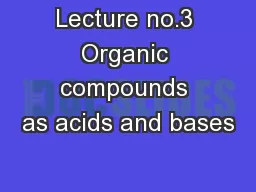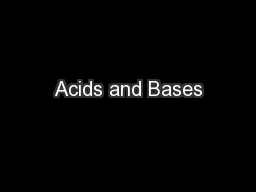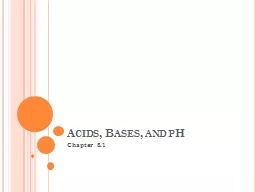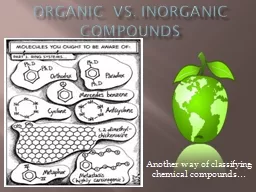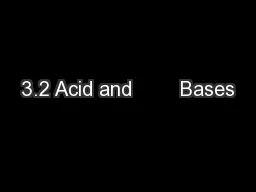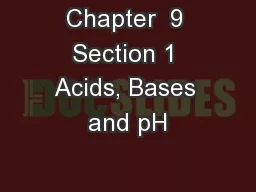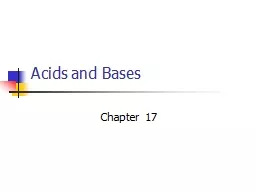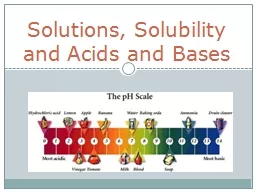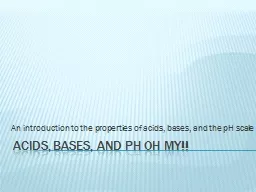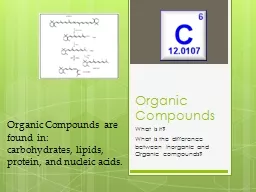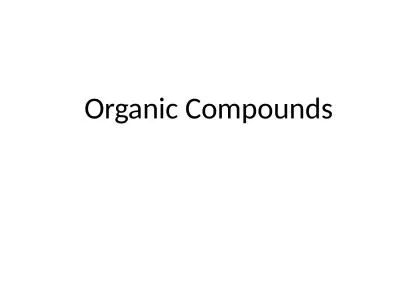PPT-Lecture no.3 Organic compounds as acids and bases
Author : mitsue-stanley | Published Date : 2018-02-25
The Brønsted Lowry Definition of Acids and Bases 1 Acid is a substance that can donate or lose a proton Base is a substance that can accept or remove a proton
Presentation Embed Code
Download Presentation
Download Presentation The PPT/PDF document "Lecture no.3 Organic compounds as acids ..." is the property of its rightful owner. Permission is granted to download and print the materials on this website for personal, non-commercial use only, and to display it on your personal computer provided you do not modify the materials and that you retain all copyright notices contained in the materials. By downloading content from our website, you accept the terms of this agreement.
Lecture no.3 Organic compounds as acids and bases: Transcript
The Brønsted Lowry Definition of Acids and Bases 1 Acid is a substance that can donate or lose a proton Base is a substance that can accept or remove a proton 1 Hydrogen chloride a very strong acid transfer its proton to water. . The taste of lemons and lime, the bite of sourdough bread, and the tang of a tomato are all caused by acids. Acids may be defined as substances that produce H. +. ions in solution. Citric acid, acetic acid, and tartaric acid are shown here.. Topic 8.4. A. cids. w. hen a . STRONG. acid dissolves- all, or nearly all, of the acid molecules dissociate to produce H. +. . or H. 3. O. +. ions (reaction goes to “completion”). have a . very. Acid and Base Notes. I can distinguish between an acid and a base.. I can list the characteristics of an acid and a base.. I can name acids.. I can name bases.. What do you think an acid is?. Give an example of an acid.. Chapter 8.1. Objectives. Describe the ionization of strong acids in water and the dissociation of strong bases in water.. Distinguish between solutions of weak acids or bases and solutions of strong acids or bases.. Another way of classifying chemical compounds… . Organic Compounds. In science, organic compounds contain . carbon. (. C. ), and usually . hydrogen. (. H. ). Carbon has four electrons in its valence shell, which allows for more chemical bonding possibilities than any other element.. Chemistry. Jacqueline P. Hancock, B.S., . M.Ed. Acid-Base Theories. Bracken Cave, near San Antonio, Texas, is home to twenty to forty million bats. Visitors to the cave must protect themselves from the dangerous levels of ammonia in the cave. Ammonia is a byproduct of the bats’ urine. You will learn why ammonia is considered a base.. . Acids and their properties. An acid is any compound that increases the number of . hydronium . ions. . Hydronium forms when and H separates from an acid and bonds with water = H. 3. O. . Acids have a . Explain the chemical composition of acids and bases, and explain the change of pH in neutralization reactions.. D12. I can differentiate between acids and bases.. Learning Target. When dissolved in water, they ionize (form ions). A special solution. Acids and bases are ALWAYS in a water solution.. Your body has water in it so they are always dangerous to living things.. Bases are just as dangerous as acids.. In low . concentrations. Three Kinds of Mixtures. 1. A . solution. is an evenly-mixed mixture where you can. ’. t see its different parts. Solutions have the same properties throughout.. They can be in solid, liquid or gas form. Acids and bases are solutions. . An introduction to the properties of acids, bases, and the pH scale. Complete the following table. Element. Atomic. #. Mass #. Protons. Electrons. Neutrons. Ion, Isotope, or Neutral?. 82. 209. 16. 18. Dr. Ron . Rusay. Fall . 2012. Chapter. 3. Structure . and . Bonding. Acids and Bases. Models of Acids and Bases. Arrhenius. : Acids produce H. . & bases produce OH. . ion in aqueous solutions .. What is the difference between Inorganic and Organic compounds?. Organic Compounds are found in:. carbohydrates, lipids, protein, and nucleic acids.. What is a organic compound?. An organic compound is any member of a large class of gaseous, liquid, or solid chemical compounds whose molecules contain carbon. . Organic compounds must have carbon and hydrogen. Some examples of organic compounds includes carbohydrates, proteins and lipids. . Inorganic Compounds . Inorganic compounds have either one or none of carbon and hydrogen. Water is inorganic as it only has hydrogen and carbon dioxide is also inorganic. .
Download Document
Here is the link to download the presentation.
"Lecture no.3 Organic compounds as acids and bases"The content belongs to its owner. You may download and print it for personal use, without modification, and keep all copyright notices. By downloading, you agree to these terms.
Related Documents

